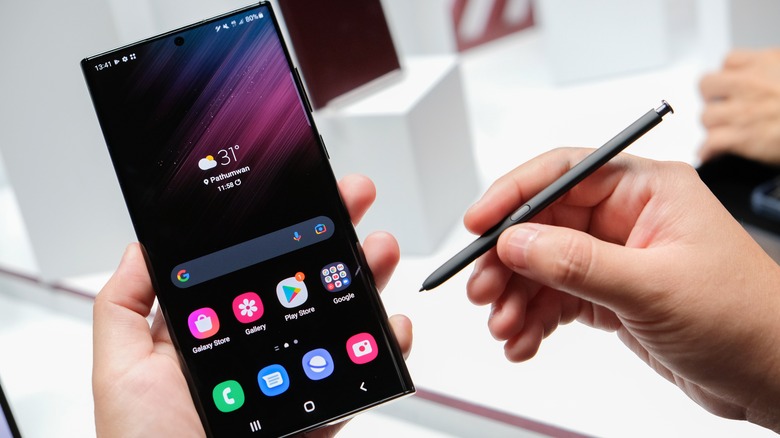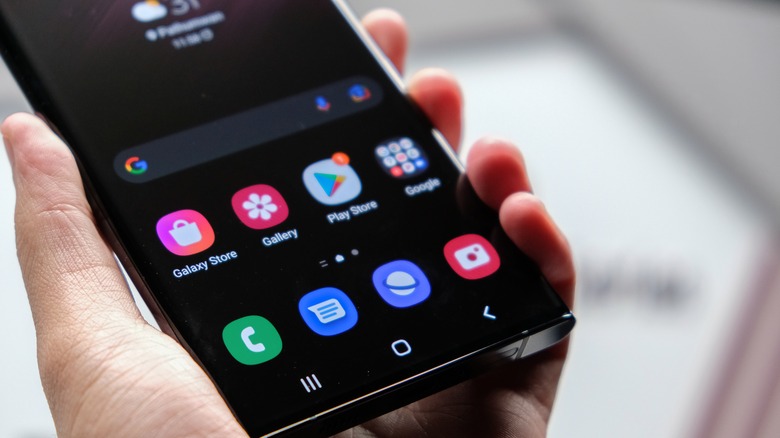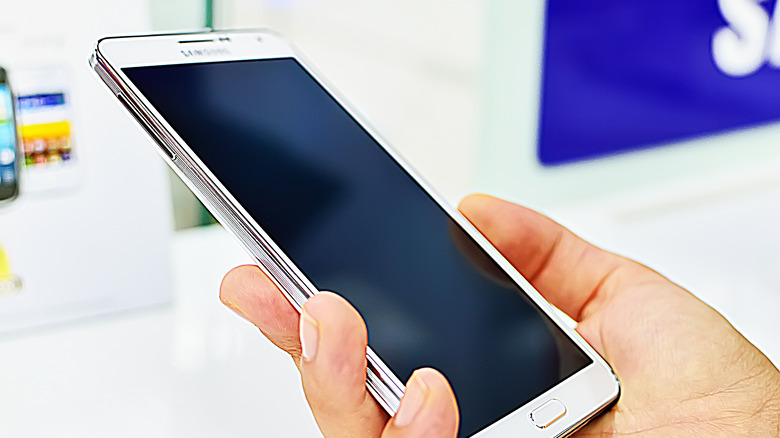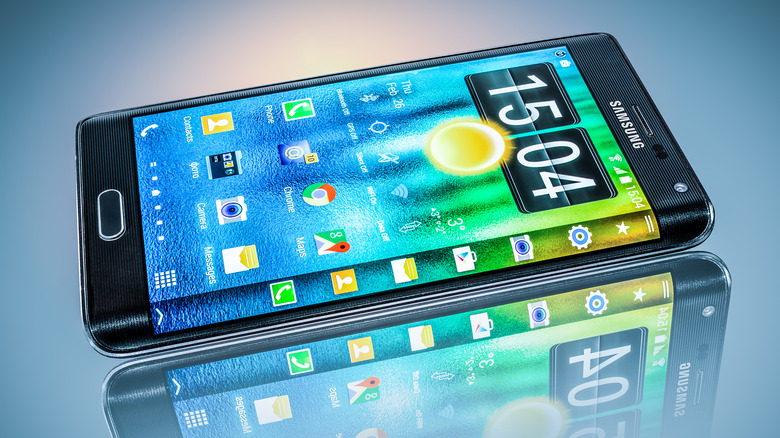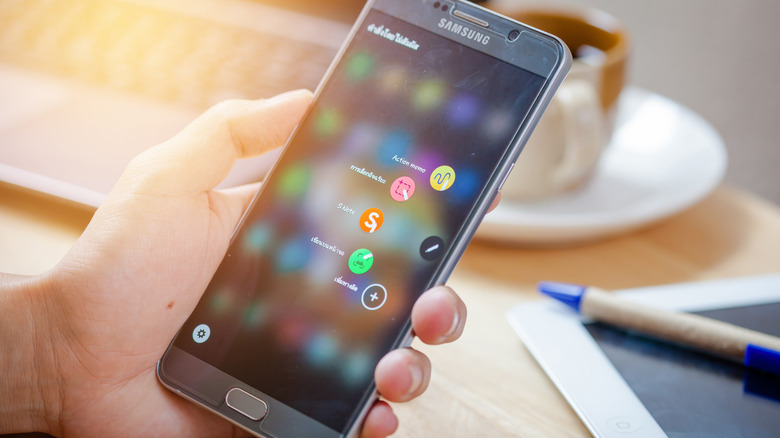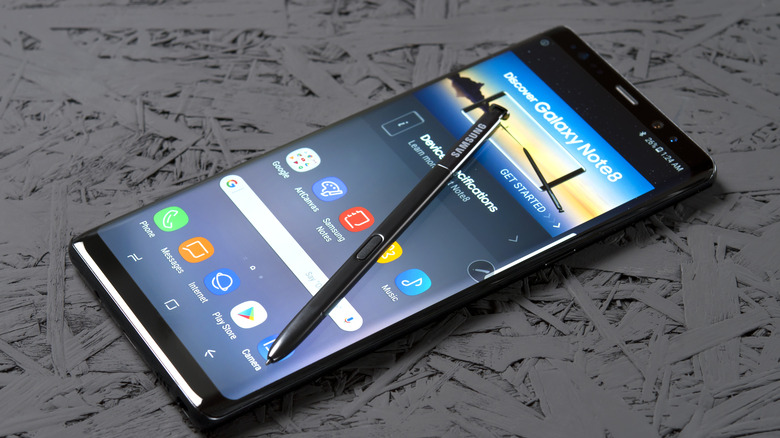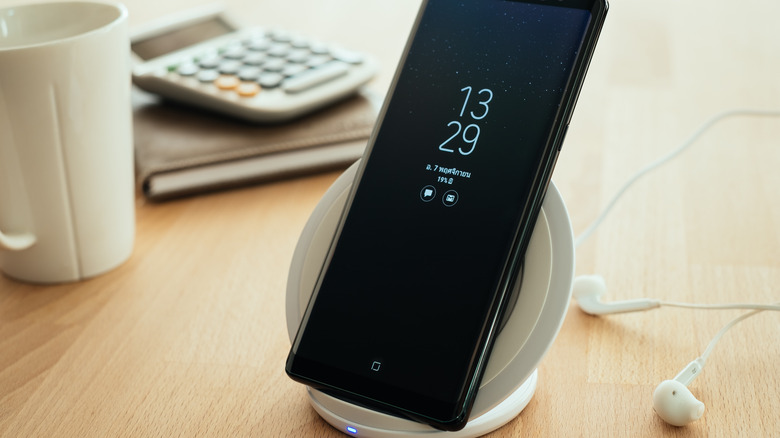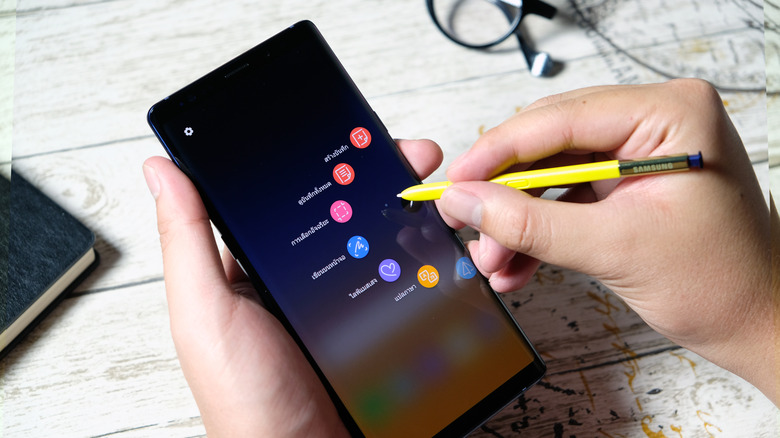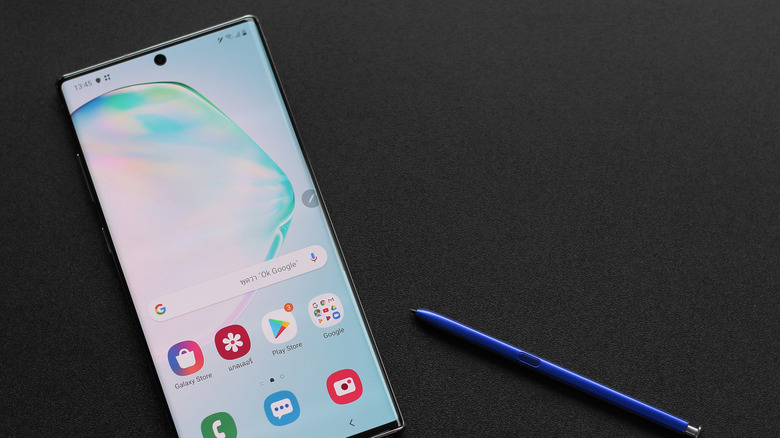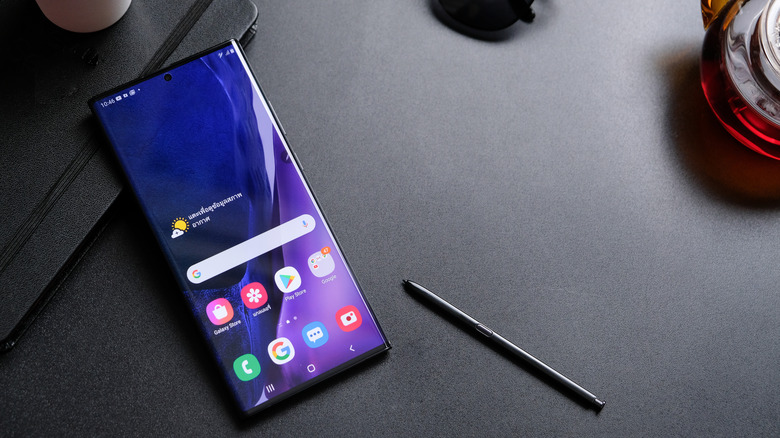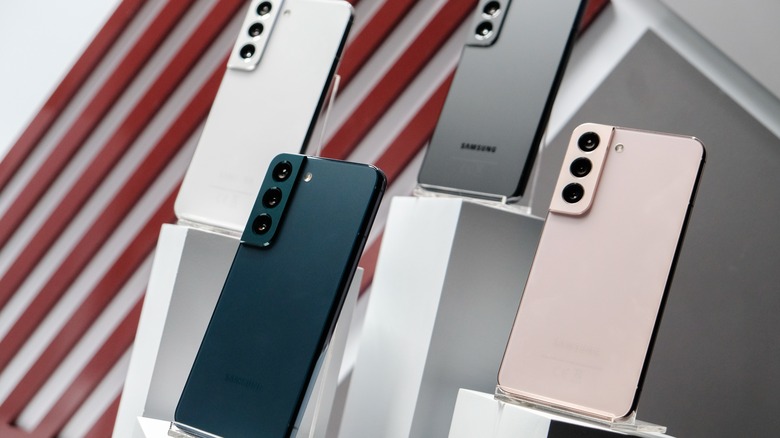The Rise And Fall Of Samsung's Galaxy Note Series
We may receive a commission on purchases made from links.
In the early stages of the smartphone revolution, and just four years after Steve Jobs announced the iPhone, the iPhone, Samsung's first Galaxy Note altered the way consumers thought about smartphones. And throughout the 2010s, the Galaxy Note remained one of the market's most feature-packed — and, of course, pricey — smartphones. Thus, it became a prime choice for individuals who wanted to enjoy the full power of smartphone technology, and perhaps those who wished to distinguish themselves by social status.
Unfortunately, the Galaxy Note series came to a sudden end in 2020 when the last of its kind was released. Two years after the fact, tech creators and smartphone users continue to speculate as to what might have caused the demise of the Note lineup. It is likely that this happened not due to one reason in particular, but a series of occurrences — including the public fallout from the Note 7 battery fires in 2016, the replacement of Samsung's CEO, and the reduced sales numbers of the Note.
For smartphone enthusiasts who would have expected to celebrate the 11th anniversary of the Galaxy Note this year, the stoppage of the Note lineup would indeed be disappointing. Yet, this does not mean that Samsung has abandoned its habit of industry-defining innovation. And with particular respect to the Note, it could be the case that the phablet never died out, but morphed into another phone category.
2011: The Galaxy Note Disrupts the Industry
Before the first Galaxy Note was released, Samsung had penetrated the smartphone market through its flagship Galaxy S phone lineup. The first Galaxy S, launched in June 2010, was a statement phone that had a simple but effective selling point: emphasis on software customization for smartphone users. Running Android 2.1, it offered owners the chance to truly make their phones "their own" using an array of applications and software features.
After gaining significant traction from the first two Galaxy S phones, with the Galaxy S II released in May 2011, it was time for Samsung to make another statement. And that they did. The Galaxy Note hit the smartphone market in October 2011, and it was like nothing the world had ever seen. In contrast to the minuscule but industry-standard 4-inch display of the Galaxy S or the 4.3-inch screen of the S II, the Galaxy Note was built with a 5.3-inch display. This "phablet" (phone plus tablet) also featured Android 2.3, a Qualcomm Snapdragon S3 chip in North American markets, and a Samsung-made Exynos 4210 in other parts of the world. Samsung also set a precedent by including a stylus, called the S Pen, with the Galaxy Note.
Although the Galaxy Note was ridiculed for being "too large" for a daily driver, however, this skepticism by the media did not affect its sales records. Within the first ten months of its existence, Samsung had already sold ten million units.
2012 - 2013: The Growth Years
Building upon the market acceptance of the Galaxy Note, Samsung decided to go even bigger with the lineup. The 2012-launched Galaxy Note 2 featured a 5.5-inch screen, improved hardware, ergonomic design, and increased functionality for the S Pen; giving users more enjoyable experiences. Note 2 was the first Samsung phone to have the split-screen feature, making it possible to view two app screens simultaneously. In addition, the S Pen allowed for screens to be previewed without being fully open — a feature Samsung tagged Air View feature. Within the first two months of Note 2's release, Samsung had sold up to three million units.
But these sales numbers were completely outdone by those of the Samsung Galaxy Note 3, which was released in 2013 as the annual successor to the Note 2. The Galaxy Note 3 featured a 5.7-inch 1080p Full HD display, larger than that of the Note 2. It was designed with a leather-textured back, a stronger Gorilla Glass 3 screen, and an improved audio system.
The Note 3 was also the first phone to be released to the market with 3GB of RAM, further improving the processing power and task management. And Samsung extended the functionality of the S Pen, adding a command menu for shortcuts. Little wonder why the phone was an instant hit in the smartphone market. This was evidenced by the fact that Samsung sold more than ten million units of Note 3 in only two months of its launch.
2014: The Edge Makes its Debut
For its 2014 annual refresh, Samsung decided to test out two new models. The first was the Galaxy Note 4, through which Samsung attempted to simultaneously offer a unique product with exceptional services. Unlike other Note phones before it, Note 4 included an array of extended features like a heart rate monitor and health/fitness apps. Samsung's philosophy with the Note 4 was that if smartphones were to be at the core of users' lives, then they must perform more life-related functions. Thus, the idea of tech ecosystems began to gain ground in the market. And in addition to these new features, the Note 4 also launched with the all-new Gorilla Glass 4 screen protecting a Quad-HD panel, a 16-megapixel camera with optical image stabilization, a fingerprint sensor, and more functionality for the S Pen.
The second innovation in 2014, and perhaps the more outstanding of the two, was the Galaxy Note Edge. Samsung had been touting curved smartphone displays for almost two years, even releasing the Samsung Galaxy Round in 2013. The Note Edge was Samsung's attempt to introduce a curve to the flagship Note phones and thus provide a unique experience for that market. Though not as curved as the Round, the Galaxy Note Edge was designed with a smooth, waterfall-like curve on the right edge of its display. And the edge could be customized to show app and website shortcuts. Despite its increased functionality, Samsung sold less than 700,000 units in total.
2015: The Golden Age Continues
While Samsung did not continue with the Note Edge in 2015, it still released an improved Galaxy Note 5 in its 2015 event. The Note 5 improved the Note 4 in multiple categories, including a refined hardware design with a glass back, new camera modules with 16MP at the back and 5MP at the front, and a faster chipset. But just as new features were included in the phone, some previously existing specs were ousted: the Note 5, for instance, eliminated the microSD card slot, leaving users to utilize base storage of 32GB, 64GB, or 128GB as preferred.
Also, unlike previous Note models, the Galaxy Note 5 was the first Note phone to have a non-removable battery. This was to safely allow for fast charging and minimize damage to and accidents involving the battery. Soon afterward, the non-removable battery became an industry standard for smartphones, and one would be hard-pressed to find a new smartphone today with a removable battery.
2016: A New Form Factor
In an attempt to balance its annual Galaxy Note releases with the Galaxy S lineup, Samsung skipped the expected Note 6 moniker for its 2016 refresh. The Galaxy Note 7, launched five months after the Galaxy S7 featured a form factor considered futuristic at the time. It had slimmer bezels than all previous Note phones, a slightly curved glass screen at the lateral edges, a 5.7-inch, 1440p Super AMOLED display, and up to 4GB of RAM.
Note 7 was designed to be not only aesthetically pleasing to its owners — it was also more functional. Samsung reintegrated the microSD card slot, once again allowing for expandable storage on the Note phones. The phablet also featured an iris scanner for improved security and payments, enhanced functionality for the S Pen, and an IP68 rating for dust and water resistance. Notably, the Galaxy Note 7 was the first Note phone to come with a USB-C port against the micro-USB port used on earlier Note phones.
As the numbers proved, the Galaxy Note 7 was set to be a much-appreciated upgrade from the Note 5. Following Samsung's massive success with the S7, the Galaxy Note 7 recorded the highest pre-order numbers of any Samsung phone at the time, with more than 200,000 pre-orders within 48 hours in South Korea alone. But just as the electronics giant was about to begin celebrating another technological breakthrough and sales milestone, the worst happened.
Cue the Fireworks
Reports began to emerge worldwide that Galaxy Note 7 models were exploding internally while charging. After more than 30 reports, and with video evidence making waves on the internet, Samsung decided to recall all the Note 7 smartphones already sold — amounting to more than 1 million recalled phones. Even worse, some of the replacement phones given to customers also exploded. By the time Samsung had quit manufacturing the Galaxy Note 7, the number of explosions numbered in the hundreds globally. And Reuters estimates that Samsung lost up to US$17 billion in the disaster.
Considering that this occurred just months after the hoverboard battery explosions, it was unsurprising that manufacturers began to doubt the efficacy of lithium-based batteries as the best means of energy storage for electronics. As Samsung explained, however, the explosions were due to manufacturing and design flaws. For the original Galaxy Note 7 models, the ignition occurred due to a lack of space for housing internal components, which expand as their temperature increases — such as the battery. And for the replacement models, there were problems with the battery chemistry from the manufacturing stage.
Of course, the Samsung Galaxy Note 7 was not the first mobile phone with an exploding battery. In 2007, for instance, Nokia recalled 46 million batteries for risks of explosion due to overheating. Moreover, the battery issues affected less than 0.01% of Galaxy Note 7 phones (via CNET). But it was a severe problem nonetheless.
2017: Redemption Season
Samsung's 2017-released smartphones were more than just a yearly refresh; they were Samsung's attempt to regain and secure consumer trust in the brand. The first of the two phones launched was the Galaxy Note Fan Edition, taken to be an apology for the mess that was the Note 7. The Note FE was Samsung's first note phone to include a pre-installed version of Bixby, Samsung's digital assistant. For precautionary purposes, Samsung stuck with a smaller, 3200mAh battery for the FE in addition to other safety features. The Note FE also came with a 5.7-inch Super AMOLED display, 4GB of RAM and 64GB of internal storage, several new sensors, including the barometer and accelerometer, and the S Pen. However, the phone was sold only in select parts of Asia, and thus its sales records are difficult to compare against older Note phones.
Months later, Samsung also released its main flagship Note for 2017. The Galaxy Note 8 took a leap in screen size, featuring a 6.3-inch Super AMOLED display, and protected by Corning Gorilla Glass 5 on the front and back of the phone. The Note 8 was also Samsung's first note to feature two rear cameras with a Dex-enabled feature: users could project the Note 8 screen to a monitor and operate the phone like a computer. More so, users could now blur the backgrounds of their photos similar to a standard DSLR camera. Fortunately, it broke multiple sales records on its first weekend of launch.
2018: Rising Storage, Falling Demand
The Galaxy Note 9 debuted in August 2018, becoming the first phone by Samsung to offer up to 512GB of internal storage and 8GB of RAM. With a new and faster processor, a Bluetooth-enabled stylus, an improved internal thermal design, and even the AR-emoji feature, Note 9 was built to push the frontiers of smartphone innovation even further. But the demand was not as high as expected. Only about 9.6 million units of Note 9 were sold, and even the Galaxy S series suffered a year-on-year decline in phone sales.
Two major reasons have been identified for this occurrence. First, it is likely that consumers did not see much of a reason to upgrade from the Galaxy Note 8. Though the Note 9 refresh launched with several novel specifications, the difference in user experience between the Note 9 and Note 8 was not so great as to warrant splurging at least $1,000 on a new device.
Second, it could be that smartphone users simply began to explore other powerful phone options, especially the Xiaomi and OnePlus phones. Back in 2018, the competition in the smartphone market had gotten so tense that even the so-called smartphone titans — Samsung and Apple — were losing customers by the day. In any case, Samsung still raked in millions of dollars from the Galaxy Note 9, and no one would have foreseen at this time that the Galaxy Note lineup was on the verge of extinction.
2019: The Beginning of the End
In 2019, for the first time, Samsung decided to adopt a pattern it had been following with the Galaxy S series. The base-version Galaxy Note 10 featured a 6.3-inch Dynamic AMOLED display, 8GB of RAM, and faster Exynos and Qualcomm Snapdragon chipsets. With a triple camera setup at the rear and a hole-punch camera at the front, the Note 10 was also the first Note phone to feature reverse-wireless charging: users could charge another phone wirelessly by placing it on the back surface of the Note.
Even more emphatic was the Galaxy Note 10 Plus, a 6.8-inch behemoth with up to 12GB of RAM and a larger 4300mAh battery, among other top-tier specifications. Note 10 Plus was Samsung's attempt to properly define the audiences for its phones and ascertain if sales would increase with multiple versions of the Note. And it worked. It is reported that the Note 10 series sold astonishingly in South Korea, and in other parts of the world.
Samsung also released two more phones in this Note 10 set. The first was the Galaxy Note 10 5G, which was a combination of specifications from the Note 10 and Note 10 plus. For instance, the Note 10 5G featured a 6.3-inch display analogous to the Note 10, but it also shipped with 12GB of RAM like the Note 10 Plus. The second phone was the Galaxy Note 10 Lite, a scaled-down version of Note 10 for buyers with a smaller budget.
2020: The Best — and Last — Note Yet
For its 2020 refresh, Samsung decided to skip to number 20 for its smartphones and ditch the 'Plus' suffix for its high-end Note phones. Following the release of its S20 series, Samsung launched the Note 20 set in August 2020. This set consisted of the base-variant Note 20 and the Note 20 Ultra, both of which had 5G-enabled versions. The Note 20 was quite large for a base version, featuring 6.7 inches of Super AMOLED Plus display, three rear cameras with a 64MP main camera, the latest Exynos and Snapdragon chipsets (at the time), and a 4300mAh battery.
The Galaxy Note 20 Ultra, on the other hand, was a beast of a smartphone. With a 108MP main camera, a 120Hz screen refresh rate, and up to 4500mAh in battery storage, the Note 20 Ultra was the quintessential definition of a phablet. When compared with older Note phones, it exemplified just how far Samsung had come in this decade-defining journey of smartphone innovation.
The Note 20 series was also a case in point for Samsung's interest in tech and smartphone ecosystems. Partnering with Microsoft, Samsung facilitated the process of running smartphone apps on a PC for various purposes. The Note 20 5G and Note 20 Ultra 5G also supported several improvements and functions due to their faster internet connectivity. Despite these improvements, however, the Note 20 series posted disappointing sales records. Thus, Samsung decided to cut down on the manufactured phone units.
Post-2020: The End of the Galaxy Note Series?
Indeed, Samsung's answer to the declining sales figures of the Note Series was not to test out a new, innovative feature. It was instead to put an end to the phone line. With the replacement of its smartphone division head in 2020, Samsung revealed that it would no longer be releasing Note phones. Moreover, Samsung has sought to establish itself in the foldable smartphone market. With the Galaxy Z Fold and Galaxy Z Flip lineups, Samsung hopes that it is getting ahead of the curve on smartphones that will define the next decade.
It would appear at first glance, however, that Samsung simply phased the Note series into its S lineup, tagging them as the S Ultra phones. The S22 Ultra, for example, features a large display and the S Pen, analogous to Note phones.
And these suspicions would not be wrong: Roh Tae Moon, chief of Samsung's smartphone division, announced in February 2022, "갤럭시노트는 앞으로 매년 '울트라'로 나온다," which translates to, "The Galaxy Note will be released as 'Ultra' every year from now on." Thus, the market still exists for individuals who wish to experience the best of what Samsung has to offer.
As to whether the Galaxy Note moniker shall make a return, one can only wait and see. Today's tech world is full of surprises, and it should not be far-fetched to think that Samsung will reuse the Note name again in the future. For now, one is left to enjoy this journey of smartphones as they keep evolving.
